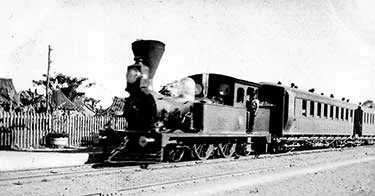When Passenger Train Service Ran from Calamba to Batangas City
When I was a small boy back in the sixties, I used to hear of trains that one could take if one wanted to go to Baguio up north or Bicol down south. In Batangas, even then, public train service was already non-existent.
That there used to be one, I had always assumed. After all, the school buses that ferried us to and from Fernando Air Base and Our Lady of the Rosary Academy uptown in Lipa would always slow down before crossing the railroad track that intersected the gravel and asphalt road at that curve in Tambo in front of the chapel.
When I had already transferred to intermediate school in La Salle, once in a while our classes would be distracted when a train passed along the tracks behind the school property. Everyone, naturally, looked out the windows.
These trains, however, had open cargo cars laden with sugarcane which, or so we heard it said, were being ferried to a refinery in Canlubang.
But there was also a station reminiscent of those one sees in American cowboy movies located almost at the corner of the street behind the school property, what is now called Lorenzo Ruiz Road leading to Canossa Academy. So we all assumed that there were passenger trains that once passed through.
In high school, I joined the Citizens’ Military Training hike to the SOS facility in barangay San Vicente, and we walked along the train tracks to get there. The tracks ran behind the SOS compound. We all conjectured that the tracks must have run all the way to Batangas City; but nobody really knew.
Thanks to the wonder that is the Internet, now I have confirmed that the tracks did, indeed, run all the way to Batangas City and probably even as far as the Municipality of Bauan.
At the height of its operations, the Philippine National Railways operated train services from Manila to La Union in what was known as the North Main Line and from Manila to Albay in what used to be called the South Main Line. At one point, however, the PNR also served Cavite and Batangas.1
 |
| Image credit: Batangas Railways. Posted by user Pinai on the Indonesia v the Philippines discussion board on www.city-data.com. |
The tracks branched off from the main line going south near the present day plant of Coca-Cola in Calamba City.2
That station behind La Salle in Lipa was apparently just one of several from Calamba to Batangas City where passengers could get off. There were also stations in Sto. Tomas, Tanauan, Luta in Malvar, San Jose, Batangas City and Bauan.3
Although the Batangas line has been dead for some time, the tracks are still fairly easy to trace on Google Earth. Inevitably, the line has been encroached upon by squatter communities, which ironically make the lines easy to trace.
Exactly when public train service to and from Batangas disappeared, I am unable to establish. Based on the very personal memories I have cited in this same article, however, we can all assume that it ended at the very latest in the early fifties but likely even much earlier.
After all, most of the railroad tracks laid down in the country before World War II were regrettably destroyed because of it. After the war, only 452 route kilometres of the more than one thousand previously in existence were still operational.4
The Batangas line, therefore, could have very well been among those tracks that were not rehabilitated after the war. Why it was not, one can glean from the very insights given about the decline of rail transport in the Philippines in general.
An article entitled “Railways in the Philippines: Its History and Corruption-tainted Track Record” published on the web site Mabuhay Radio explains: “The American colonisers weren’t too keen on developing further the railways, preferring to build roads and highways. Filipino leaders complained that the American obsession with highways reflected a bias for the American automobile industry.5”
At the time, the PNR was still known as the Manila Railroad Company.
The sentiment that the railroad industry in this country declined due to the rival transport industries is echoed in a historical article published at the official web site of the PNR: “In the decade of the 70s government priorities shifted and a pan-Philippine highway was built. And the railroad was relegated to its own backwaters as the buses and trucks and the much faster airliners took over.4”
Decades later and ironically, road congestion is forcing the Department of Land Transportation into a revival of the Batangas line in what is being called the North-South Railway Project or NSRP.
The project calls for “…construction and rehabilitation of approximately 653km commuter railway operations from Tutuban to Calamba and long haul rail operations on the branch line from Calamba and Batangas…6”
Talk of reviving the Batangas railway service has been going on since the Presidency of Fidel V Ramos, so as with many things in Philippine government, the NSRP should be taken with a grain of salt. Besides, the project appears to be entirely reliant upon a Mar Roxas Presidency.
On the other hand, who is not dreaming of a hassle-free trip from Batangas to Metro Manila?
2 Laguna Railways
3 List of Philippine National Railways Stations, Wikipedia
4 PNR in Philippine History
5 Railways in the Philippines: Its History and Corruption-tainted Track Record published in Mabuhay Radio
6 New north-south commuter railway set, Official Gazette.
